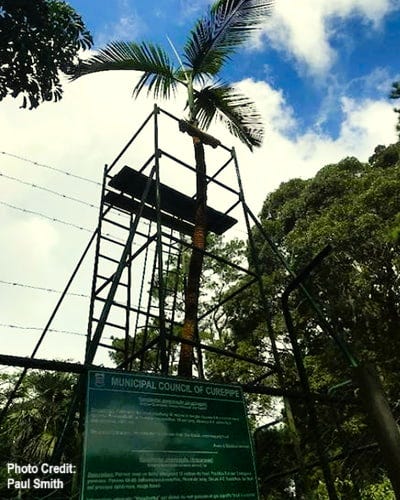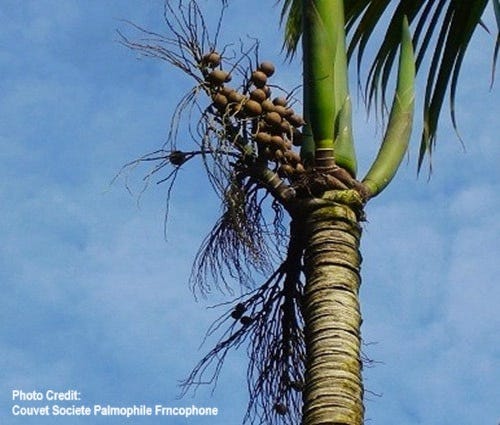Spotting the World's Loneliest Palm 😟
Meet the rarest palm tree and why its identification captivates the world!
Hello!
Why is this Loneliest Palm Tree's sad tale disheartening?
Remember the song "One" by Three Dog Night? It begins "One is the loneliest number that you'll ever do." If this palm had ears, it would be identifying with that intro!
Some palms live in unexpected places, face surprising challenges, and even hold a Special Place in Culture & History. But this palm is distinctly unusual and can illustrate the importance of conservation.
We'll explore this one such palm today by sorting out:
How this palm is the loneliest palm tree in the world.
Identifying this Hyophorbe & its cousins.
What the future holds for Hyophorbe amaricaulis.
To the west of Madagascar, in the Southern Indian Ocean sits the island country of Mauritius. Visit there, and you'll soon hear that Curepipe Botanical Gardens is a must see!
Mauritius was made first and then heaven.
– Mark Twain
Why go there?
If you can, do it! Cause if we could, we'd go! But for now, it's only on our "To Do List."
But really it's because within that garden, we can all come upon this remarkable palm: Hyophorbe amaricaulis. Locally called the Hurricane Palm.
Why It's Lonely
This palm is the rarest of all palms. So rare, it's actually known to be the last of its species on the entire planet.
Imagine being the only one of your kind! Having to live in an enclosure. Does it remind you of Solitary Confinement?
Yet this palm has an existence that speaks to survival and resilience. And yes, also loneliness.
The Hyophorbe amaricaulis grows within a tall barbed wire fence to prevent interference from meanies. A scaffolding aids biologists in the work to help it survive. Estimates are that it's 150-200 years old!
Things To Understand About The Loneliest Palm
It has seemed unable to reproduce naturally. The inflorescence (flower stalk) has many branches. On it are off-white flowers for reproduction. With pollination comes murky brownish-red fruits & seeds.
Scientists helped it begin the reproducing process through hand-pollination. Which encouraged fruit growth.
They then tried encouraging Seed Propagation With Another Method.
With that, researchers at Kew Gardens in 2010 managed to grow some seedlings in the lab.
But when transplanted into soil, they all died.
They haven't yet tried again! See a further Discussion of the Issue Here>
Identifying Looks for the Hyophorbe Genus Also Makes It Special
This loneliest palm has a few relatives. In the Hyophorbe genus, all the palms have several identification characteristics common to all five species:
Solitary (single) trunks & pinnate fronds.
Crowns have thinly distributed fronds, only about 6.
Stunningly vivid crownshafts.
Branching inflorescences begin budding just under the crownshaft.
All Are Monoecious, which means male and female flowers grow on inflorescences of the same palm.
The Hyophorbe Species has only one that's considered not endangered. Perhaps, we're thinking, because it grows quickly. It's H. indica, native to La Réunion, an island 109mi/175 km southwest of Mauritius.
In the whisper of a dying palm's leaf, Lies a quiet tale of Earth's grief. For each frond that fades away, Nature mourns, both night and day.
We Have A Useful Resource
For your quest to understand the quirks in the H. amaricaulis palm tree's survival story, this Kew Remedy Updates You in discovering how they've worked on this issue. As well as A Cycad that is perhaps an even more dire situation.
3 Actions Help to Appreciate Rarity and Resilience
First, visit (as we often suggest!) a botanical garden.
To engage your senses in ways books and screens cannot.
To witness many palm species.
But if you see any of the four endangered species, count yourself fortunate. If H. indica is there, enjoy visiting the loneliest palm’s cousin. And observe their common traits.
Second, animate your curiosity.
Appreciating rare species isn’t just about observation.
It involves asking questions and understanding the history and challenges.
Now you'll have a basis for addressing some questions to a garden or nature reserve docent.
Third, active conservation efforts.
Get involved, or educated about Conservation Efforts.
Knowing that you play a role in preserving biodiversity might transform the way you perceive nature.
You'll be making every encounter with all wildlife precious.
Thinking About What You Learned Today
The Hyophorbe amaricaulis is the last of its kind, holding a special place in Curepipe Gardens.
Scientists tried out plans to help it reproduce.
This Hyophobe and others in the genus are special cases.
Taking action steps helps nurture your Knowledge of Palm Parts.
Conserving rare species is vital to maintaining Earth's biodiversity.
It's a race against time to save this unique species. We hope you enjoyed this palm species exposé.
Watch for us next month, when we'll have more identification tips. Take care everyone.









I read somewhere that relatively speaking palm species are inherently rare, in part because their seeds tend not to be easily dispersed (with exceptions obviously!). And habitat destruction of course has exacerbated that, in this case and others. I've always felt part of the attraction of palms was this intrinsic "specialness," geographically-speaking, on top of the fact that they stand out so much morphologically.